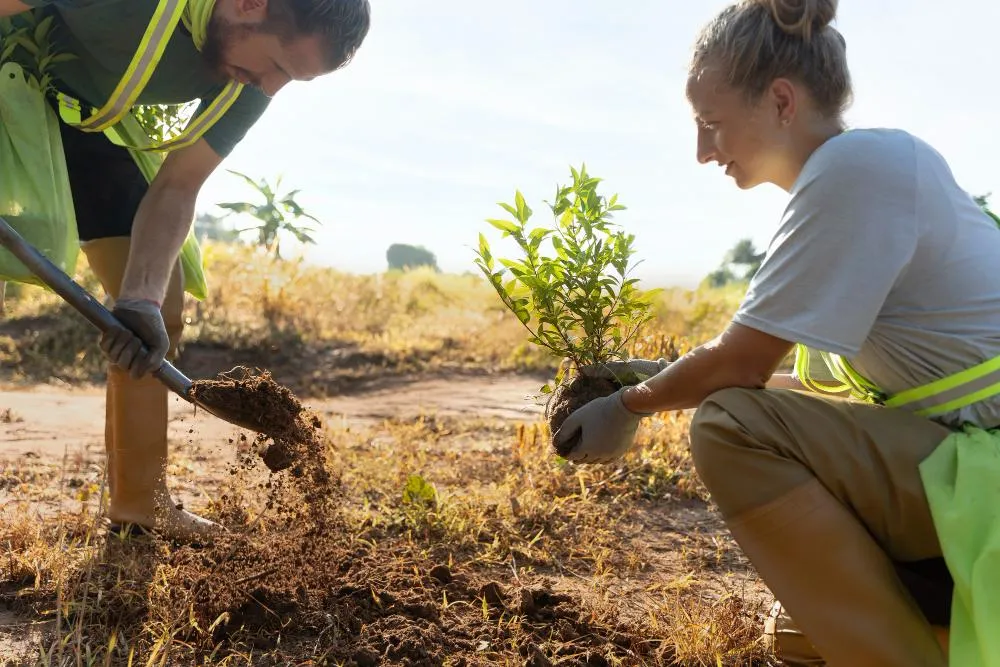
Tree Planting Services That Last: How to Choose, What It Costs & What to Expect
Are you looking to enhance your landscape while contributing to a greener planet? You’re not alone.
In fact, according to the U.S. Department of Agriculture, a single mature tree can absorb over 48 pounds of carbon dioxide annually, helping to clean the air and release oxygen in return. That’s not just a fun fact—it’s one of the many reasons homeowners and businesses are turning to professional tree planting services to improve their properties and the environment at the same time.
But here’s the thing: planting a tree isn’t as simple as digging a hole and dropping in a sapling. Poor choices and improper planting techniques often lead to wasted time, money, and—worst of all—unhealthy trees that never reach their full potential. Trust me, we’ve seen more than a few “DIY disasters” where good intentions resulted in sickly trees, wasted money and frustrated owners.
The solution? By leveraging expertise in tree care services—from selecting native trees to ensuring proper placement and aftercare—you can guarantee your investment thrives for decades. So, whether you’re planning to refresh your backyard, boost your business’s curb appeal, or support your local ecosystem, you’ll find everything you need to know right here. Let’s dig in!
Why Professional Tree Planting Matters
Look, anyone can buy a tree from the garden center and pop it in the ground. But—here’s the kicker—only about 62% of homeowner-planted trees survive beyond the first five years (according to USDA Forest Service research). Contrast that with a professional approach, where survival rates routinely exceed 90%. That’s not just luck; it’s expertise.
The Hidden Benefits of Expert Tree Planting
Long-term Health: Pros know how to avoid root girdling, soil compaction, and other common pitfalls.
Optimal Placement: Arborists consider sunlight, wind, drainage, and proximity to structures—stuff that’s easy to overlook when going solo.
Biodiversity & Native Species: Experts can help you choose native trees that support local wildlife and require less maintenance.
Warranty & Support: Many tree planting services offer guarantees or aftercare, so you’re not left hanging if something goes wrong.
Personally, we’ve seen businesses transform dull parking lots into lush, inviting spaces—just by selecting the right native trees and letting professionals handle the planting. The change isn’t just visual; it’s a boost for employee morale and customer perception (and yes, there are studies linking green spaces to increased happiness).
Environmental Impact: Small Choices, Big Results
Trees do more than decorate—they clean the air, reduce urban heat, and even increase property values by up to 15%. When you work with professional tree planters, you’re not only investing in your property but also contributing to global reforestation and carbon sequestration efforts.
The bottom line: Professional tree planting services are about more than convenience—they’re about ensuring your investment flourishes, your landscape thrives, and your impact stretches far beyond your fence line.
Choosing the Right Trees for Your Property
Here’s a scenario we see all too often: someone falls in love with a fast-growing exotic tree, only to watch it struggle (or worse, become invasive) in their local climate. Choosing the right tree isn’t just about aesthetics—it’s about harmony with your environment and long-term success.
The Power of Native Trees Planting
Native trees are adapted to your region’s soil, climate, and pests. That means less water, fewer chemicals, and far lower maintenance. For example, in the Midwest, planting oaks or maples can support over 500 species of caterpillars, compared to just a handful for imported ornamentals.
Reduce watering needs by up to 50%
Encourage pollinators and beneficial wildlife
Minimize risk of disease and pest infestations
How Pros Evaluate the Best Fit
Professional tree planters don’t just glance at your yard and start digging. They evaluate:
Soil type and drainage: Sandy, clay, loam—each has its quirks.
Sunlight exposure: Full sun, partial shade, deep shade.
Wind patterns and microclimates: Especially important in open or urban areas.
Long-term growth: Will this tree crowd your foundation or power lines in 10 years?
Here’s a tip: Ask your tree care service about the “right plant, right place” principle. It’s not just a slogan—it’s the secret to a sustainable, low-maintenance landscape.
Understanding the Tree Planting Process
So, what actually goes into professional tree planting? Spoiler alert: it’s way more than just “dig hole, insert tree.” Here’s a real-world breakdown from years spent both planting and troubleshooting:
Step-by-Step: What to Expect from Tree Planting Services
Site Assessment: The pros inspect your soil, drainage, and site conditions. (Pro tip: some services use soil testing kits to spot hidden issues.)
Tree Selection: Based on your goals, budget, and local climate, you’ll get recommendations for the best species and sizes.
Preparation: This may include soil amendments, removing turf, or correcting drainage problems.
Planting: Trees are planted at the correct depth, with roots spread (not jammed), and staked if needed. Proper mulch is added—but never piled against the trunk! (That’s a classic rookie mistake.)
Initial Watering & Care: Deep watering and sometimes root stimulants help with establishment.
Aftercare Plan: You’ll get instructions (often in writing) or follow-up visits for pruning, watering, and fertilization.
Here’s the truth: Cutting corners at any stage can doom your tree from the start. For instance, planting too deeply is a leading cause of mortality in urban trees (International Society of Arboriculture).
Actionable Tips for Homeowners
Ensure your service marks underground utilities before digging (it’s the law in many areas!)
Ask for a written planting plan and aftercare instructions
Request species that are at least 2-3 years old for best survival rates
In our experience, the best outcomes happen when homeowners stay involved—ask questions, follow up on aftercare, and keep records of their trees’ progress. It’s your investment, after all!
Tree Planting Cost: What to Expect
Let’s be honest: cost is often the elephant in the room. So, what does professional tree planting actually cost? The answer depends on several factors, but here are some industry benchmarks to guide your budget.
Breaking Down the Costs
Tree Size: A 5-gallon sapling might run $50–$100 installed, while a mature 10-foot specimen can jump to $500 or more.
Species Choice: Rare or slow-growing species cost more than common natives.
Site Preparation: Extra grading, soil amendments, or removal of old stumps can add $100–$500 per tree.
Quantity: Many companies offer discounts for bulk planting (think commercial projects or new developments).
According to HomeAdvisor, the average tree planting cost in the U.S. is $150–$850 per tree in 2024, with most homeowners spending about $500 for a mid-sized tree installed by a professional.
What’s Included?
Tree selection and sourcing
Site prep and soil amendments
Planting, staking, mulching
Initial watering and aftercare guidance
Optional: warranties or follow-up visits
Here’s a little insider advice: Always ask if the quote is “all-inclusive” or if there are extra charges for things like delivery, equipment, or warranty. At Melad Tree Farm, we believe transparency builds trust, so we walk clients through every line item.
Is It Worth It?
When you add up the potential costs of a failed planting—lost time, replanting, and years of lost growth—professional services often pay for themselves. And don’t forget, mature trees can increase property values, save on cooling costs, and even qualify you for local rebates or grants (check with your city or state forestry department!).
Ongoing Tree Care Services
Planting the tree is just the beginning. If you want your investment to thrive, you’ll need ongoing tree care services—especially in the critical first 3-5 years when roots are establishing.
Maintenance: What’s Actually Needed?
Watering: Deep, infrequent watering is key. Too much or too little is a recipe for failure.
Mulching: 2-4 inches of mulch helps retain moisture and regulate temperature, but keep it away from the trunk!
Pruning: Early, corrective pruning shapes strong structure and removes damaged or crossing branches.
Fertilization: Only as needed—over-fertilizing can harm young trees.
Pest and Disease Monitoring: Catch problems early before they become disasters.
According to TreesAreGood.org, trees with a dedicated maintenance plan are twice as likely to reach maturity compared to those left to fend for themselves.
When to Call the Pros
Not sure if your tree needs help? Here are some signs it’s time to bring in a certified arborist:
Wilting, off-color, or dropping leaves (not seasonally appropriate)
Visible pests or fungal growth
Cracks in the trunk or exposed roots
Sudden leaning or instability
Remember, early intervention is almost always cheaper and more effective than waiting until the problem is severe. Most reputable tree care services offer maintenance packages, seasonal inspections, or even digital monitoring with photo updates.
Actionable Tips for Healthy Trees
Create a watering calendar and adjust based on rainfall
Inspect mulch rings every few months
Schedule annual pruning with a certified tree care service
Case Studies: Successful Tree Planting Projects
Still on the fence? Let’s look at two real-world examples where professional tree planting services made all the difference.
Case Study #1: Suburban Home, Native Tree Transformation
A family wanted to boost curb appeal and shade their west-facing windows. We helped them select three native River Birch trees, known for fast growth and beautiful bark. The professional planting team amended the clay soil, installed root barriers, and set up drip irrigation.
Survival Rate: 100% after 3 years
Reduction in air-conditioning costs: Estimated $150/year
Butterfly and bird sightings increased dramatically
Case Study #2: Commercial Office Park, Low-Maintenance Landscaping
A local business wanted a “set it and forget it” landscape that still looked impressive. We designed a plan using native oaks and serviceberries, planted by professionals equipped with heavy machinery for proper placement.
Initial investment: $7,500 for 20 mature trees
Maintenance costs: 40% lower than previous non-native plantings
Employee satisfaction: Surveyed 85% “happier with the view”
These aren’t just numbers—they’re proof that making smart choices with the help of professionals pays off for years to come.
Key Takeaways: Making Tree Planting Services Work for You
Professional tree planting services dramatically increase tree survival and long-term value.
Choosing native trees means less maintenance, more wildlife, and water savings.
Understand the complete process—from site assessment to aftercare—for best results.
Tree planting cost varies, but investing up front saves money (and headaches) long-term.
Ongoing tree care services are essential for healthy, thriving landscapes.
Real-world case studies prove the impact of expert guidance and planning.
Always request detailed quotes, aftercare instructions, and choose companies with strong reputations.
Conclusion
Professional tree planting services do more than just beautify your property—they help create a healthier environment, support biodiversity, and boost your home or business value. By understanding the selection process, costs, and the importance of ongoing care, you set your trees—and yourself—up for long-term success.
Ready to take the next step? Contact Us for a personalized site assessment, expert advice, and a detailed quote tailored to your landscape needs. Let’s plant the seeds for a greener, more beautiful tomorrow—starting today!
